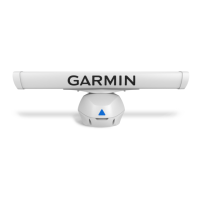Wiring and Connection Considerations
It may be necessary to drill a hole up to 32mm (1
1
/
4
in.) in diameter for routing the power, network, or
grounding cables.
You must apply marine sealant to the hole after the cables are in place to ensure a waterproof seal.
If you must make the routing hole in a visible location, 32mm (1
1
/
4
in.) decorative cable grommets can be
purchased from your local Garmin dealer, or you can go to garmin.com (optional).
• If needed, you can trim the grommet to enable you to route multiple cables through the same hole.
• The optional grommet does NOT provide a waterproof seal. You must apply marine sealant to the grommet
after the cables are in place to ensure a waterproof seal.
When installing the cables, you should observe these considerations.
• The ground cable is not included, and must connect to a water ground location, not the negative terminal of
the battery (Grounding the Radar, page8).
• To ensure safety, appropriate tie-wraps, fasteners, and sealant should be used to secure the cable along the
route and through any bulkheads or the deck.
• You should not run cables near moving objects and high-heat sources, or through doorways and bilges.
• To avoid interference with other equipment, you should not run network and power cables parallel to other
cables, such as radio antenna lines or power cables. If this is not possible, the cables should be shielded with
metal conduit or a form of EMI shielding.
• You should install the power cable as close to the battery source as possible.
◦ If it is necessary to extend the power cable, you must use the appropriate wire gauge (Power Cable
Extensions, page8).
◦ Incorrectly extended runs of cable may cause the radar to malfunction due to insufficient power
transmission.
Connecting to Power Through the Voltage Converter
WARNING
When connecting the power cable, do not remove the in-line fuse holder. To prevent the possibility of injury or
product damage caused by fire or overheating, the appropriate fuse must be in place as indicated in the product
specifications. Connecting the power cable without the appropriate fuse in place voids the product warranty.
NOTICE
Do not reuse any voltage converters from previous Garmin radar models, or third party voltage converters. Using
any converter other than one included with the radar, or the correct converter purchased from Garmin or from
your local Garmin dealer may damage the radar or prevent it from turning on.
If your model is not packaged with a voltage converter, you can connect the power cable directly to the boat
battery (Connecting Directly to Power, page7).
When installing the voltage converter, observe these considerations.
• The voltage converter requires an input voltage of 10 to 32Vdc.
• You should install the voltage converter as close as possible to the power source.
• Connecting the power cable for the voltage converter directly to the battery is recommended. If it is
necessary to extend the cable, you must use the appropriate gauge of wire for the length of the extension
(Power Cable Extensions, page8).
5

